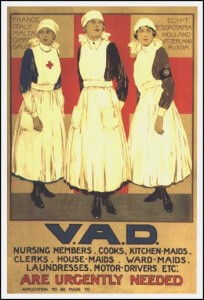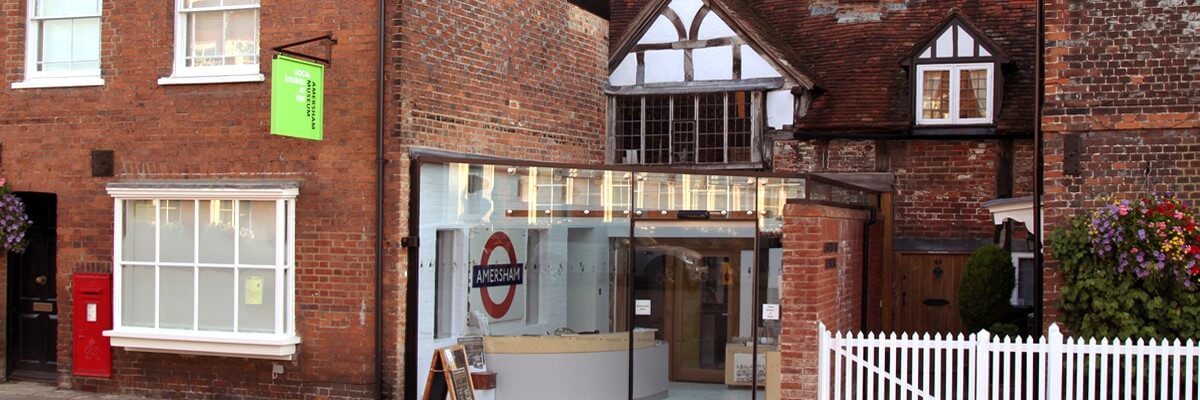Eleanora Blanshard Pemberton O.B.E.
 This article was written by Babara Webber based on recorded interviews with Miss Pemberton held by Amersham Museum, articles in the Bucks Examiner and a report from the British Red Cross Museum archives.
This article was written by Babara Webber based on recorded interviews with Miss Pemberton held by Amersham Museum, articles in the Bucks Examiner and a report from the British Red Cross Museum archives.
Miss Eleonora Pemberton was born in Kensington on 19th July 1885. She was the only daughter, but the second of five children. Her father was a solicitor who joined the family business started by his father and uncle, originally called “Lee and Pemberton’s” but soon just “Pemberton’s”.
Eleonora’s education started with a governess at home and then she went to a small school with two excellent teachers travelling there by horse-drawn bus. It was unusual in 1900 for girls to go to boarding school, but when she was 15, Eleonora went to St Felix School in Suffolk. At 18 she spent a happy year at a finishing school in Paris.
The Pemberton family moved to Buckinghamshire in 1909 to a house in Cokes Lane, on the edge of Harewood Downs Golf Course. There was a period of time after her return from Paris that her mother became ill and Eleanora took over running the household as her father had many clients who needed entertaining.

In 1912 Eleanora and some of her friends joined the British Red Cross as members of a Voluntary Aid Detachment in the City of London which had been started by a friend whose husband was Lord Mayor. Eleanora remembered marching in the Lord Mayor’s Show in that particular year. Other friends started a Detachment in Paddington and Eleanora and her friends moved there. Eventually there were two Paddington Detachments – one was run by Katharine Furse, who was the founder of the English Voluntary Aid Detachment Force and became Commandant-in-Chief, and the other was run by Rachel Crowdy who became Principal Commandant of Voluntary Aid Detachments in France and Belgium from 1914-1919.
The two Paddington Detachments provided classes in First Aid and Home Nursing which Eleanora and her friends attended in 1912-13. Eleanora said that when in 1914 there was a possibility of war, she and her friends were all keen on going out and taking part and she was lucky enough to get that chance, leaving England on 19th October 1914 “but of course we never went anywhere near the firing line. The nearest I got to it was in Boulogne, when we thought we could hear the distant cannon at Ypres, but I don’t think we could.” She continued: “our little Detachment was the only one out there until 1915. I got out there before all my brothers which was a great achievement!”
“We all expected to go and nurse the wounded, but very few of us did that – the early VADs were what I called ‘odd-jobbers’. At first there were very few ambulance trains, but temporary ones were rigged up in cattle trucks, or luggage vans, with supports fixed in order to support a stretcher. These acted as ambulance trains for the lying-down cases. There was no provision for the walking-wounded who came in ‘improvised ambulance trains’ which were just a string of ordinary 3rd class carriages, one behind the other, which would accommodate about 800 walking wounded with one medical officer in charge. As there were no corridor carriages, there was nothing he could do while the train was in motion. He could only provide help when the train stopped at a station.”
“In 1914 the Red Cross was asked to set up Rest Stations at various points along the railway journey between Boulogne and Le Havre, or Rouen. The first of these Rest Stations was at Boulogne – there was no building available, but the French railway authorities put four very dirty luggage vans at the disposal of the Red Cross in a siding at the Gare Central. The trains from Ypres would stop there for about half-an-hour and then go off again on the long journey. It was decided that the four luggage vans provided should be a kitchen, a dispensary, a quartermaster store and a rest room. By that time a men’s detachment had been allocated to us and kept a large fire burning out in the open, between the rails – they had hanging over it a sort of gypsy cauldron which was our hot water supply, for all sorts of purposes – because although we were outside the station we were not near any means of hot water or any sanitation at all.”
“When the trains came in we found the best plan was for two of the VADs to start at each end of the train and work towards the centre, handing in mugs of cocoa, and tins of bully beef and bread for each of the men in the carriage.” The VADs did their work in their uniforms of ankle length dresses and coats and large, floppy felt hats – somewhat impractical said Miss Pemberton!
After her time in Boulogne she worked at Gournay in a small cottage hospital with no electricity, gas or sanitation. All the water was supplied by the army in mobile tanks. “The men loved going to this unit, but hated to go away when they were better”. Next Miss Pemberton was Quartermaster at a station in Etaples, where she lived in a hut and was in charge of the first female ambulance drivers in France.
She then started a Rest Station in Abbeville where she was Commandant in charge. She had four VADs under her and four male orderlies. She particularly remembered dressing a man’s wounded hand and knowing it was going to hurt, she popped a Bullseye sweet in his mouth! They were a treat sent from home by her mother. Abbeville was the headquarters of lines of communication in France to the fighting and Miss Pemberton found it particularly interesting. It was for her work in Abbeville that she later received an OBE.
After returning from France after three years, Miss Pemberton worked with the Paddington Unit, giving lectures and training new recruits. In the British Red Cross, County of London Branch Report 1914-1919 Miss Pemberton is mentioned: “Paddington did a great work in enrolling and training members for special and general service. It had a larger number of members working abroad than any Division. ………….Mrs Wallace carried on the work of the Division with great energy and initiative until August 1917, when she was succeeded by Miss Pemberton who by her zeal and ability was able to further increase the activities of the Division. Miss Pemberton resigned in December 1919.”

“Pemby”, as she was known locally in later life, moved to Highfield Close, Amersham, in 1939 after the death of both her parents. She was involved with many charities, and a member of the Chiltern Club of Arts from 1929 (founded by the artist Louise Jopling in 1919) becoming President in 1982. She died in September 1994 at the great age of 109.
See also an article about two of her brothers.
You can listen to Miss Pemberton talking about her wartime experiences:
- R1_0046 Becoming a VAD
- R1_0046 Role of a VAD
- R1_0042 Lord Roberts
- R1_0042 Hospital work
- R1_0042 Sweets
- R1_0042 Recycling
- R1_0042 Cooking
- R1_0042 A letter home
- R1_0042 American dentist
- R1_0042 Rest station
- R1_0042 Trains
You can also listen to a much longer interview on the War Museum website.

